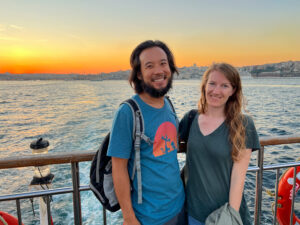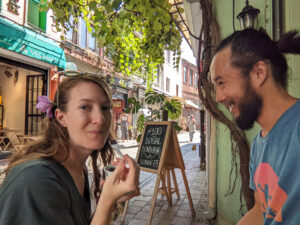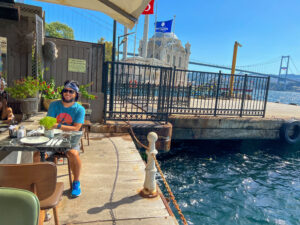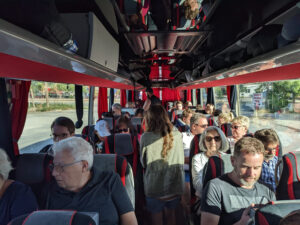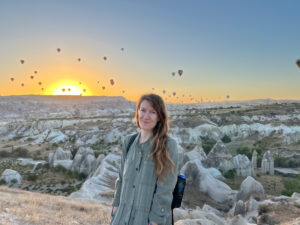
We left Pamukkale to drive 9 hours to the highlight and final destination of our tour—Cappadocia. When you see photos of Turkey, it’s so often photos of the hot air balloons over Cappadocia. You see the travel influencers on social media posing alone on rooftops in flowing gowns with the balloons floating around them like giant, incandescent bubbles. (How much are they paying to stand on this rooftop alone, I used to wonder. Now I know it’s actually not as much as you’d think.) These types of places usually give us expectations that reality can never match. But this was one of those rare exceptions where photos could never do the experience of it justice. This is officially the farthest from home I’ve ever been, and it looks like another planet. Most places you visit for the first time remind you of somewhere else, but Cappadocia doesn’t look like anything I’ve ever seen before.
Millions of years ago, volcanic eruptions covered this region with ash that eventually hardened into a soft volcanic rock. The rock eroded over time into the otherworldly landscape that Cappadocia is today. People burrowed underground and built entire cities in tunnels. Others carved their homes and churches into the cliffside rocks. Natural erosion and rivers created valleys and the fairy chimneys—rock formations that look like pillars and cones and skinny beehives. The mystery of it is haunting.
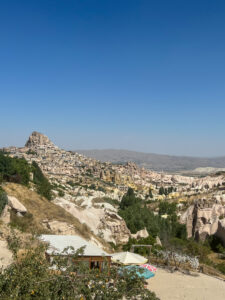
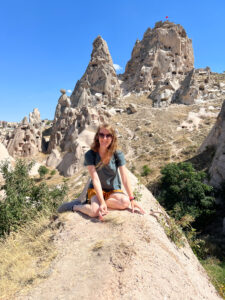
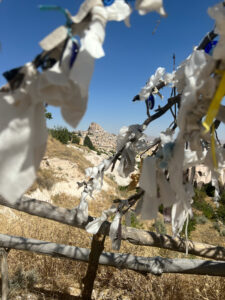
We wandered through the claustrophobic underground city of Derinkuyu, where 20,000 people once lived. We visited the Goreme Open Air Museum where 1,000-year-old churches were built into the cliffsides and still have original paintings covering their walls. We visited a jewelry store to learn about the gems that only exist in this area of the world, and we visited a co-op where women spend all day weaving the famous Turkish rugs with their hands. We ate pottery kabobs which were like a stew cooked inside enclosed pottery that you had to break with a hammer to eat. It was so delicious that I ate it in spite of fearing that I was consuming pottery shards. We tasted the thickest yogurt you can imagine with local honey and sesame seeds, and if my body would allow me to consume so much lactose I’d eat it for every meal.


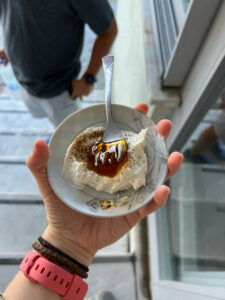

In the morning, we got up before the sunrise to watch the balloons. Hundreds of them fly together at sunrise every morning, and it’s like this strange constellation of color. Most of the group went to ride the balloons, but Michael, one of our tourmates, and I decided to watch from the ground instead. We took a taxi to a view-point while it was still dark outside, and we watched the balloons rise as the sun crept up behind them. Of all the towns and cities I visited on my trip, this is one where I desperately wished to stay longer.
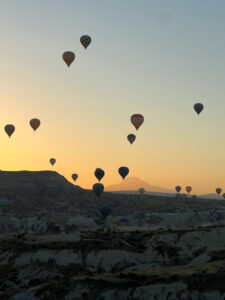
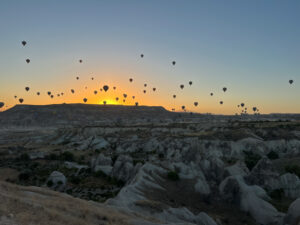
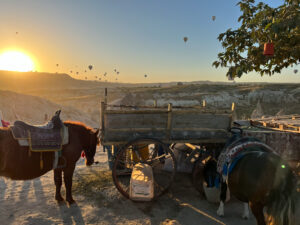

It was a long ride back to Istanbul. We passed Turkey’s capital, Ankara, which looked like miles and miles of skyscrapers in the distance. We made it back to Istanbul that evening. After traveling over 1,700 miles together in 12 days, we had to say goodbye to our tourmates/new friends. (Come to New Orleans and see us, tour friends!) I was glad to have an extra couple of days in the city after the tour ended. The two weeks we’d spent in Turkey at that point were like an orientation to teach us about all the things we still needed to see.
We got to spend one more night in our fancy hotel (and enjoy our last of many all-you-can-eat hotel buffets) before moving to a hostel for the final night. I’d slept in so many hostels at that point that it felt like moving from a hotel to the home of a friend. Cheers Vintage Hostel is just blocks away from the Hagia Sophia and Blue Mosque, and they are the kindest people. They also have a hostel dog named Milo who greeted us outside when we arrived and who I adored.
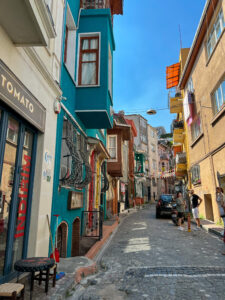
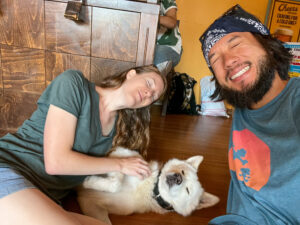
We spent two more days exploring neighborhoods we hadn’t seen yet like Belat (where the houses were painted more colors than I had names for and home to the world’s best chocolate sorbet), Ortakoy (neighborhood of the best Turkish breakfast with a view), and Besiktas (home of the most beautiful bookstore in Istanbul). We took a ferry to Kadikoy on the Asian side of the city for dinner. It felt more chaotic than the European side, full of street dogs and cafes overflowing with people and bass beating through my shoes as we passed bars and clubs.
On the last day, we visited a small mosque that I found online. The only mosques I’d ever visited had been the major tourist mosques in Turkey and the Hassan II in Casablanca (the largest mosque in Africa and the only mosque in Morocco that non-Muslims are allowed to enter). I wanted to see what it was like inside a smaller mosque and without the crowds. Michael and I were the only tourists there, and we waited for the midday prayer to end before going inside. If you visit Istanbul, you must visit the Hagia Sophia and the Blue Mosque, but I’d encourage everyone to prioritize visiting a smaller mosque, too. It gives you a more authentic glimpse of the places where most locals are going to pray, it’s far more intimate, and it’s just as beautiful.
That evening, we packed up our belongings, told Milo the hostel dog goodbye, and went to catch our trusty night train back to Bulgaria.
